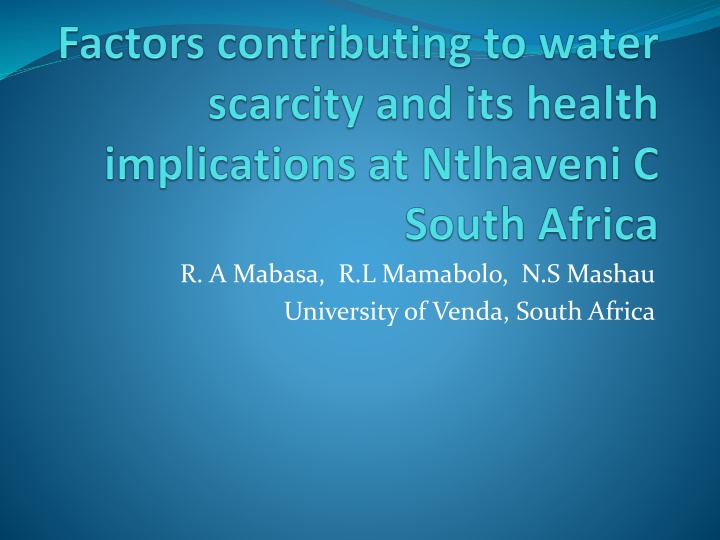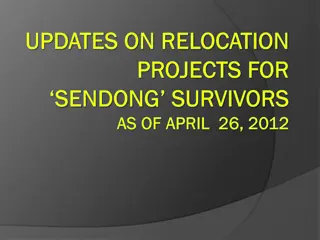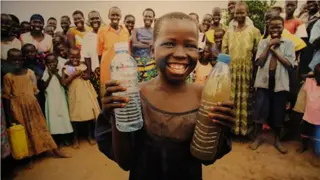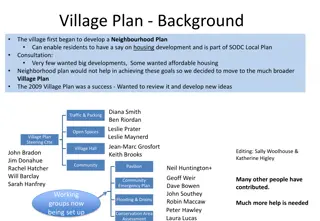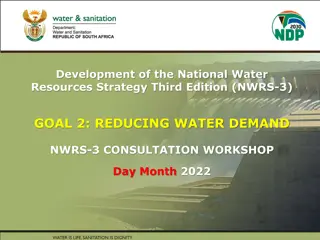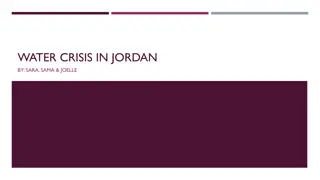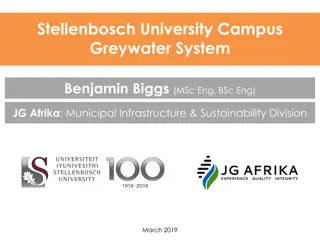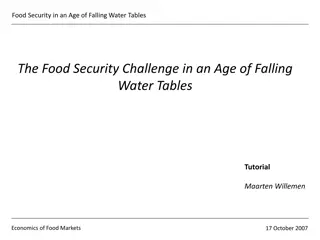Water Scarcity Study in Ntlhaveni C Village, South Africa
Study conducted in Ntlhaveni C village, South Africa, addressing water scarcity issues, health implications, and research methodology. Factors contributing to water scarcity, health risks, and community perspectives were explored through qualitative research methods in this rural setting.
Download Presentation

Please find below an Image/Link to download the presentation.
The content on the website is provided AS IS for your information and personal use only. It may not be sold, licensed, or shared on other websites without obtaining consent from the author.If you encounter any issues during the download, it is possible that the publisher has removed the file from their server.
You are allowed to download the files provided on this website for personal or commercial use, subject to the condition that they are used lawfully. All files are the property of their respective owners.
The content on the website is provided AS IS for your information and personal use only. It may not be sold, licensed, or shared on other websites without obtaining consent from the author.
E N D
Presentation Transcript
R. A Mabasa, R.L Mamabolo, N.S Mashau University of Venda, South Africa
Introduction Water is an essential resource for life and good health. Lack of water to meet daily needs is a reality today for one in three people around the world (WHO, 2009). Nearly 51 percent of the population in sub-Saharan countries lack access to safe water supply 41 percent lack adequate sanitation (WHO, 2011). Approximately 18 million rural South Africans do not have access to adequate sanitation (water & Sanitation guide, 2011).
Introduction continues Lack of access to clean water, poor sanitation and hygiene are the main risk factors attributable to diarrheal related diseases in South Africa (DWAF, 2008). The greatest concern is that people continue to adopt unsafe hygienic practices in South Africa despite an array of diversified efforts that have been mounted towards adequate sanitation (DWAF, 2001).
Problem statement Ntlhaveni C village is located in Limpopo province in South Africa, which is one of the most poorly developed province when it comes to water infrastructure. Over the past three years, there has been water scarcity where there is no piped water. Community members, therefore, fetch water from other sources like ponds, dams and rivers which are contaminated.
Objectives Describe factors that contribute to water scarcity. Determine the health implications of water scarcity.
Research design and methodology A qualitative, exploratory and descriptive design triangularly was used to explore and describe those factors contributing to water scarcity and the health implication thereof. The context of the study was the rural community in the Vhembe District of Limpopo province in South Africa. The population of the study included Ntlhaveni C community members , professional nurses from local clinic and workers from the department of water affairs.
Research design and method continues A non-probability, purposive sampling was used to ensure that community members who participated on the focus group discussions were the once who met the sampling criteria. Data collection o data was collected in three folds: Focus group discussions, written interviews and in depth face to face interviews were conducted Data saturation occurred after ten focused group discussions, six written interviews and two in depth face to face interviews.
Research design and method continues Data was analysed using Tesch s eight steps of open coding ( Creswell, 1996).
Discussion of findings Natural and man- made factors emerged as the main causes of water scarcity and they were supported by the following sub-themes: Poor water infrastructure Poor service delivery Insufficient rainfall health implications of water scarcity physical health effects water borne diseases
Discussion of findings conti.... Poor water infrastructure Participants explained that water scarcity was due to damaged water infrastructure where pipes were old and rotten and some pipes which were supposed to be underground, were outside and damaged by the sun and human activities, like walking and ploughing. They also expressed that there was a shortage of dams which was also contributing to water scarcity as there was no reliable source of water.
Discussion of findings conti When discussing water infrastructure one participant said The main lines which are coming from Malamulele are very old and rotten because they have not been replaced in a very long time, so water leaks through from them . There was only one tank in the village which was supposed to supply the whole community, sometimes once or two days a week and mostly at night.
Discussion of findings conti... Poor service delivery participants indicated that the government was failing to provide water and sanitation to the community of Ntlhaveni C, apparently before the democratic government in 1994, the community had bore holes which supplied them with water. Another participant reported that: the government is failing us because since they came into power there is never a person who came to attend to our shortage of water issue, and we are suffering because at times we do not sleep
Discussion of findings conti... Insufficient rainfall Lack of rain also contributes to people tempering with the pipe lines because they wanted water for their cattle because the dams, ponds and streams had dried up. Another participant confirmed this statement by saying that The main line passing the fields in the bush has been broken by the herd boys so that their cattle can drink water because the streams and the dams do not have water where they can drink due to lack of rain .
Discussion of findings conti... Health implications of water scarcity Physical health effects Aged participants expressed their frustrations when discussing physical health effects as they were the ones suffering most. They were forced to walk long distances with wheelbarrows and two or three 25 litres containers with water which was strenuous to their already deteriorating health.
Discussion of findings conti... Aged participants explained that if they failed to fetch water themselves, they were supposed to pay someone to fetch water for them which was adding a strain on their finances as most of them depended on old age grant. One participant said If I am to get water, I need to hire and pay a boy to fetch me water .
Discussion of findings conti... Participants explained that they were not getting enough sleep because whenever water came out, it would be during the night and they would be awake the whole night and it strenuous to their bodies especially to school children. One of the teenagers was emotional when she said we are suffering in this community because of water scarcity, we go for months without running water from the pipes, when it does comes out, it is at night and we spend the whole night trying to get water, in the morning we are tired .
Discussion of findings conti... Water borne diseases Diarrhoea statistics from the local clinic showed an increase in the incidences of diarrhoea especially in children under the age of five years and those living with HIV/AIDS since the beginning of water scarcity. participants expressed their emotional distress when talking about drinking unclean water which was making them sick.
Discussion of findings conti... one participant said we are living like animals, sometimes we are forced to drink water with them in the stagnant waters Although there were no cases which have been reported which are directly linked to drinking water with animals, some studies has shown that there are effects like stomach cramps and skin irritation due to that.
conclusion Based on the results, the following recommendations have been made: Water and sanitation committee should be established Training of home based carer on sanitation issues The clinic should work as an information centre.
